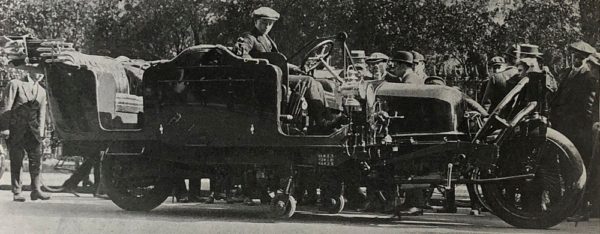
Russian Count Peter P Schilovski was a lawyer and member of the Russian royal family. In 1912 he visited the Wolseley Tool and Motorcar Company and presented to their engineers his plans for a two-wheeled gyroscopically-stabilised car. He claimed that the car would be of considerable military value; it would be able to cross terrain impossible for 4-wheeled vehicles and would require less power for the same speed.
The Wolseley people must have been impressed, because they accepted the task of building the prototype, under the supervision of A. W. Dring, the Chief Experimental Engineer. The chassis was built in under a year – a remarkable achievement, considering the experimentation necessary to turn theory into a working machine. The Count often visited Wolseley’s Adderley Park works in Birmingham to monitor progress. The car was completed in November 1913.
The Gyrocar was powered by a modified Wolseley C5 engine of 16-20 hp, mounted ahead of the radiator, driving the rear wheel through a traditional clutch and gear box. The only braking appears to have been on the transmission.
The gyroscope was 40 inches in diameter and 4.5 inches thick at the rim, and spun at between 2000 and 3000 rpm, powered by a 110V 1.25 hp electric motor tat was in turn powered by an engine-driven dynamo. If the gyro speed fell too low, sprag wheels would automatically lower to support the car; the offside one of these can be seen in our picture. A. W. Dring reported the results of the first trial run on 27 November 1913, and noted that a person could stand on the side of the car and step into the body with no ill effects upon balance. The first public demonstration took place before a large crowd in Regent’s Park on 28 April 1914. The car had a significant drawback associated with the properties of gyroscopes: it was very difficult to make it turn, except in a very wide arc. Much further development would have been needed to bring the project to commercial application.
At the outbreak of World War I in August 1914 the Count returned to Russia and Wolseley simply stored the car. Hearing nothing from the Count, they assumed that he had been a casualty of the hostilities and would not return – so they dug a pit in which they tipped the car.
In 1938 the company decide to exhume the Gyrocar. There are photographs of this activity. The car was restored at great expense and put on display in the company museum. The car was broken up for scrap in 1948.
Count Schilovski did survive the First World War, the Revolution, and the civil war that followed. He returned to England around 1922, lived there with his wife and three daughters, and worked for the Sperry Gyroscope Company.
He wrote an article for the May 1939 issue of The Morris Owner, advocating gyrocars and accepting that the original Gyrocar had been too heavy.
Picture courtesy of the Richard Roberts Archive







Leave a Comment